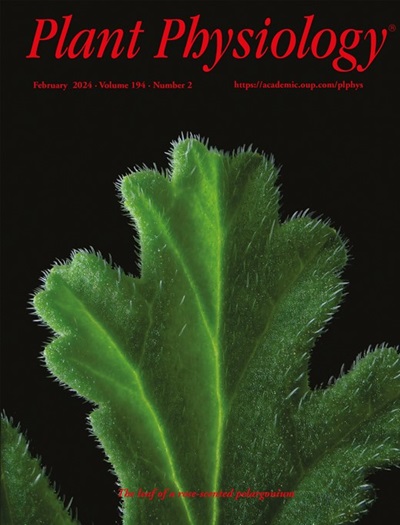The N6-methyladenosine reader ECT1 regulates seed germination via gibberellic acid- and phytochrome B-mediated signaling.
IF 6.5
1区 生物学
Q1 PLANT SCIENCES
引用次数: 0
Abstract
Seed germination, a pivotal stage in plant growth, is governed by phytohormones such as gibberellic acid (GA) and influenced by phytochromes, which are key photoreceptors in plants. The N6-methyladenosine (m6A) RNA modification is fundamental to plant growth and development. However, the molecular mechanisms underlying the regulation of PHYTOCHROME B (phyB) and the function of m6A signaling in GA-mediated seed germination remain elusive. Here, we discovered EVOLUTIONARILY CONSERVED C-TERMINAL REGION 1 (ECT1) as an m6A reader protein that directly binds to m6A and forms homodimers to enhance its stability in Arabidopsis (Arabidopsis thaliana). We observed that the ect1-1 mutant exhibits attenuated GA3 responsiveness in seed germination. Restoration of ECT1 function in ect1-1 confirmed the role of ECT1 in promoting seed germination. Our findings indicate that ECT1 promotes seed germination by destabilizing m6A-modified REPRESSOR OF GA1-3 1 (RGA1), a key inhibitor of GA-mediated seed germination. Moreover, ECT1 establishes a regulatory circuit with DOF AFFECTING GERMINATION 2 (DAG2), another regulator of GA-mediated seed germination. DAG2 directly binds to the ECT1 promoter and controls its transcription, and ECT1 modulates DAG2 mRNA stability through m6A binding. Furthermore, we identified PHYB as a common downstream target of DAG2 and ECT1. ECT1 binds directly to m6A-modified PHYB and influences its stability, and DAG2 binds to the PHYB promoter to regulate its transcription. Our findings demonstrate that ECT1 fine-tunes m6A-regulated seed germination via complex and multifaceted molecular mechanisms, particularly through interactions with GA and phyB, broadening our understanding of m6A-regulated processes in Arabidopsis.n6 -甲基腺苷解读子ECT1通过赤霉素酸和光敏色素b介导的信号传导调节种子萌发。
种子萌发是植物生长的关键阶段,受赤霉素等植物激素和光敏色素的影响,光敏色素是植物的关键光感受器。n6 -甲基腺苷(m6A) RNA修饰是植物生长发育的基础。然而,光敏色素B (phyB)调控和m6A信号在ga介导的种子萌发中的作用的分子机制尚不清楚。在这里,我们发现进化保守的c -末端区域1 (ECT1)是一个m6A读取器蛋白,它直接与m6A结合并形成同型二聚体,以增强其在拟南芥中的稳定性。我们观察到ect1-1突变体在种子萌发中表现出减弱的GA3响应性。ECT1在ECT1 -1中的功能恢复证实了ECT1在促进种子萌发中的作用。我们的研究结果表明,ECT1通过破坏m6a修饰的GA1-3 - 1抑制因子(RGA1)来促进种子萌发,RGA1是ga介导的种子萌发的关键抑制剂。此外,ECT1与DOF影响萌发2 (DAG2)建立了调控回路,DAG2是ga介导的另一种种子萌发调节剂。DAG2直接与ECT1启动子结合并控制其转录,ECT1通过m6A结合调节DAG2 mRNA的稳定性。此外,我们发现PHYB是DAG2和ECT1的共同下游靶点。ECT1直接与m6a修饰的PHYB结合并影响其稳定性,DAG2与PHYB启动子结合调节其转录。我们的研究结果表明,ECT1通过复杂和多方面的分子机制微调m6a调控的种子萌发,特别是通过与GA和phyB的相互作用,拓宽了我们对m6a调控拟南芥过程的理解。
本文章由计算机程序翻译,如有差异,请以英文原文为准。
求助全文
约1分钟内获得全文
求助全文
来源期刊

Plant Physiology
生物-植物科学
CiteScore
12.20
自引率
5.40%
发文量
535
审稿时长
2.3 months
期刊介绍:
Plant Physiology® is a distinguished and highly respected journal with a rich history dating back to its establishment in 1926. It stands as a leading international publication in the field of plant biology, covering a comprehensive range of topics from the molecular and structural aspects of plant life to systems biology and ecophysiology. Recognized as the most highly cited journal in plant sciences, Plant Physiology® is a testament to its commitment to excellence and the dissemination of groundbreaking research.
As the official publication of the American Society of Plant Biologists, Plant Physiology® upholds rigorous peer-review standards, ensuring that the scientific community receives the highest quality research. The journal releases 12 issues annually, providing a steady stream of new findings and insights to its readership.
 求助内容:
求助内容: 应助结果提醒方式:
应助结果提醒方式:


